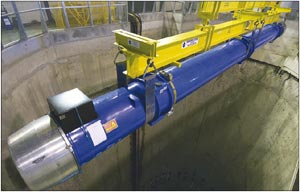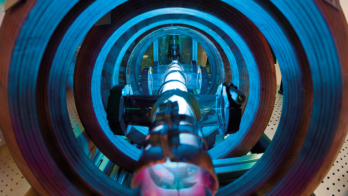On 26 April, the last superconducting magnet for the LHC descended into the accelerator tunnel. The hundreds of guests attending the final lowering ceremony applauded as the superconducting dipole, 15 m long and weighing 34 tonnes, descended through the PM12 shaft. Few of the guests would be well-versed in the Welsh language, but all intuitively understood the inscription on the banner at the top of the shaft: “Magned olaf yr LHC” (Last magnet for the LHC), in honour of Lyn Evans, the LHC’s (Welsh) Project Leader.

The PM12 shaft, which was created for the express purpose of lowering the long magnets into the tunnel, has seen 1232 dipoles pass down over the past two years, and 1746 magnets in total. Before going underground, the magnets were fitted with beam screens and underwent final tests and welds in the SM12 hall above the shaft. The lowering operation was a massive challenge owing to the quantity, size and fragility of the items, not to mention the tight deadlines. In addition, it took nearly 10,000 truck journeys to transport the magnets from the various locations where they were stored in France and Switzerland – a total of some 40,000 km, all at 10 kph.

Earlier in the month, on 4 April, work began on the last stretch of interconnections in the LHC as brazers began welding on the final octant, between Points 1 and 2. All of the LHC magnets will be interconnected by September, by which time the teams working on them will have made 123,000 connections in only two years. The task of connecting up all of the machine components has also been a challenge. Vacuum systems, superconducting cables, beam screens, cryogenic pipes and thermal and electrical insulations all have to be interconnected, with each interconnection requiring about 60 operations.
For all of the teams involved, another great challenge is to work in parallel with other ongoing activities. During the final phase, some 200 engineers and technicians, half from CERN and half from the contractor, are working in the LHC tunnel under rather difficult conditions. The work involves a collaboration between CERN, the Krakóv Institute of Nuclear Physics (HNINP) and the Franco–Dutch consortium IEG, which took responsibility for the interconnection work and for supplying welding and brazing machines.
At the same time, physicists and engineers from CERN, Fermilab, Lawrence Berkeley National Laboratory and KEK are preparing to repair 18 sets of structural supports for quadrupole magnets built at Fermilab, one of which failed a high-pressure test in the LHC tunnel in March. The failure was in a magnet that is part of an “inner triplet” of three magnets, Q1, Q2 and Q3. To fix a design flaw in the supports, the team has proposed to add to each Q1 and each Q3 a set of four cartridges that can absorb the longitudinal force generated during the pressure test. The cartridges are stiff mechanical springs that will be installed parallel to the magnet’s cold mass.
The final design reviews for the cartridges will take place at Fermilab and CERN before the end of May and installation of the cartridges in the Q1 and Q3 magnet of at least one inner triplet is scheduled to be complete in early June, in time for the next pressure test. The work can be done in the LHC tunnel, with the magnets in place. Only the inner triplet damaged during the previous pressure test will be removed for repairs of its structural supports.





